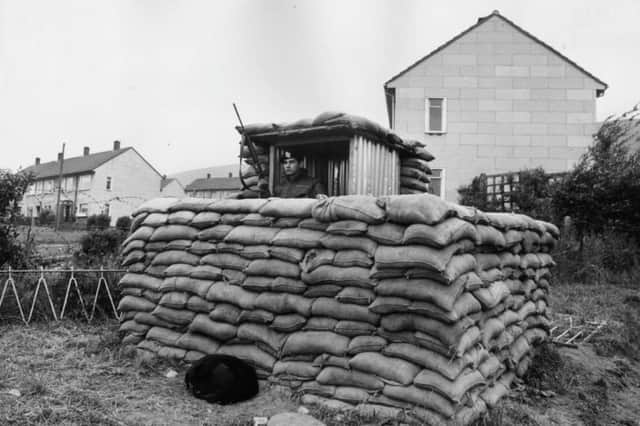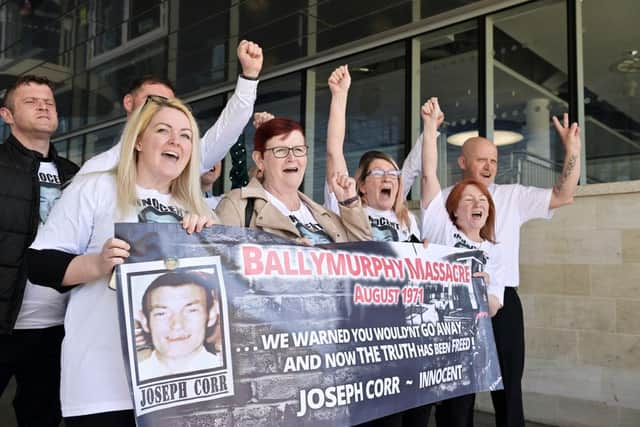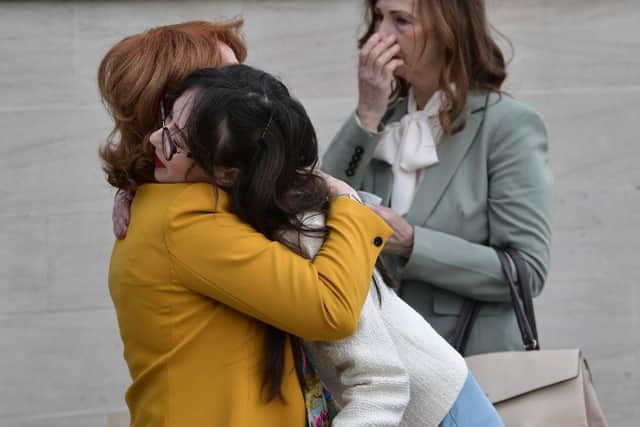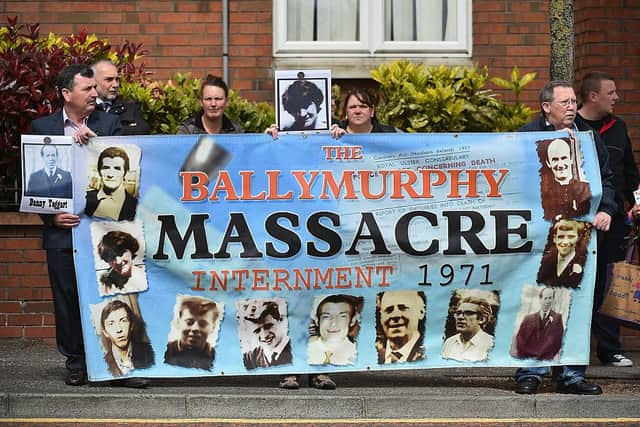Ballymurphy Massacre: Belfast's Bloody Sunday explained – and what innocent inquest verdict means for families
This article contains affiliate links. We may earn a small commission on items purchased through this article, but that does not affect our editorial judgement.


The British Army has been found to be responsible for nine of the 10 deaths in August 1971, which included a mother-of-eight and a Catholic priest.
The shootings later became known as “Belfast's Bloody Sunday” – a reference to the killing of civilians by the same battalion in Derry a few months later – and the "Ballymurphy Massacre”.
Advertisement
Hide AdAdvertisement
Hide AdReacting to the findings, Northern Ireland’s deputy First Minister Michelle O’Neill claimed it was “British state murder”.


She tweeted: “The victims and the families of the Ballymurphy Massacre have been vindicated and the truth laid bare. This was British state murder.”
But what exactly was the Ballymurphy Massacre?
Here is everything you need to know.


What was the Ballymurphy Massacre?
The Ballymurphy massacre was a series of incidents that took place between 9 and 11 August 1971, at the height of “the Troubles”.
Over three days, the 1st Battalion, Parachute Regiment of the British Army killed 10 civilians in Ballymurphy, in an area of Belfast just west of the Northern Irish city.
Advertisement
Hide AdAdvertisement
Hide AdThose civilians were caught up in Operation Demetrius, a British Army operation involving the mass arrest and imprisonment of hundreds of people suspected of being involved with the Irish Republican Army (IRA) without trial.


The IRA was waging an armed campaign for a united Ireland against the British state, and so the British Government approved proposals from the Northern Ireland Government for a spate of dawn raids throughout the country.
Due to faulty intelligence, many of those arrested had no links with the IRA, and the raids sparked mass protests and violence in which 20 civilians were killed across Northern Ireland.
Members of the Parachute Regiment stated that, as they entered the Ballymurphy area, they were shot at by republicans and returned fire, and that those killed in the shootings were Republican gunmen.
Advertisement
Hide AdAdvertisement
Hide AdHowever, those accounts had been disputed ever since by the families of those killed, who professed their innocence. That innocence has now been confirmed, 50 years on.
What happened to the 10 people found innocent?
Ten fresh inquests were heard in terms of the incidents in which they occurred.
Presiding Coroner Mrs Justice Keegan acknowledged it was a chaotic time in Northern Ireland but ruled that the use of force by soldiers had been “disproportionate” in the nine deaths the Army was found as responsible for.
Parish priest Father Hugh Mullan, 38, and Frank Quinn, 19, were shot in the Springfield Park area of Ballymurphy around 9pm on 9 August 1971.
Advertisement
Hide AdAdvertisement
Hide AdBoth are thought to have been going to the aid of a wounded man, with Father Mullan reputedly waving a white cloth to indicate his innocent intentions. The coroner found they were killed by shots fired by soldiers, and that the force used was not justified.
Around the same time, outside an Army barracks at the Henry Taggart Hall in Divismore Park, Noel Philips, 19, Joseph Murphy, 41, Joan Connolly, 44, and Daniel Teggart, 44, were fatally wounded by gunfire.
The coroner found these killings were also not justified, and that the victims were “innocent” and unarmed.
The following day, Eddie Doherty, 31, died after being shot in the Whiterock Road as he came across an encounter between soldiers and protesters who had erected a barricade across the road.
Advertisement
Hide AdAdvertisement
Hide AdThe coroner ruled that the use of force in shooting Doherty was disproportionate. She also rejected claims that he had been throwing petrol bombs at the time.
On the third day of shooting, Joseph Corr, 43, and John Laverty, 20, were also shot in the Whiterock Road area in the early hours of the morning. Corr died from his injuries 16 days later.
The coroner concluded that the two men were shot by the British Army and there was no evidence that they could have been shot by anyone else. She also rejected claims that the pair were gunmen who had been firing at soldiers.
Former soldier John McKerr, 49, was shot later that morning in Westrock Drive as he took a break from maintenance work. He died of his injuries on 20 August 1971.
Advertisement
Hide AdAdvertisement
Hide AdJustice Keegan said he was an entirely innocent man, but there was not enough evidence for her to determine where the shot that killed him came from, or whether it was fired by the military or paramilitaries.
She noted that McKerr was a “proud military man” and claims that he was associated with the IRA had caused great pain for his family in the five decades since.
What does the innocent ruling mean?
There were joyous scenes outside the coroner’s court in Belfast as families emerged holding placards with the faces of their loved one with the words “innocent” written on each.
Justice Keegan noted that, 50 years on, the deaths remain “stark” for the families.
Advertisement
Hide AdAdvertisement
Hide AdIrish Foreign Affairs Minister Simon Coveney said the findings have “cast a tremendous new light on one of the darkest pages of the history of the conflict”.
He said the findings will come as an “immense relief and vindication for the families who have maintained for decades that their loved ones were innocent and their killings unjustified”.
What comes next?
On the same day as the innocence ruling (11 May), the Queen set out the Government’s programme in her first major public ceremonial appearance since the death of her husband, the Duke of Edinburgh.
Around 30 pieces of legislation were promised in the speech, but missing was a Bill on dealing with the legacy of the Troubles in Northern Ireland, although Prime Minister Boris Johnson has said legislation will be introduced.
Advertisement
Hide AdAdvertisement
Hide AdIssues around the treatment of veterans of the Troubles have been highly controversial amid suggestions that protection from prosecution offered to service personnel may also be extended to loyalist paramilitaries and terrorists.
Johnson said the Government’s legacy package will deliver “better outcomes for victims, survivors and veterans”, focused on reconciliation and ending the “cycle of investigations”.
In reference to a signal by the UK Government that it will introduce legislation to address the legacy of the Troubles, Sinn Fein President Mary Lou McDonald said the inquest findings are bittersweet.
“Today will be bittersweet as the British Government confirms that they will now attempt to block the families from getting justice, in defiance of an international agreement signed with the Irish government on dealing with the past,” she said,
Advertisement
Hide AdAdvertisement
Hide Ad“The Stormont House Agreement was about facilitating the pursuit of truth and justice in a balanced, transparent and fair manner. Their intention to now to totally walk away from the Stormont House Agreement is totally unacceptable and it cannot go unchecked and unchallenged."
A message from the editor:
Thank you for reading. NationalWorld is a new national news brand, produced by a team of journalists, editors, video producers and designers who live and work across the UK. Find out more about who’s who in the team, and our editorial values. We want to start a community among our readers, so please follow us on Facebook, Twitter and Instagram, and keep the conversation going.
